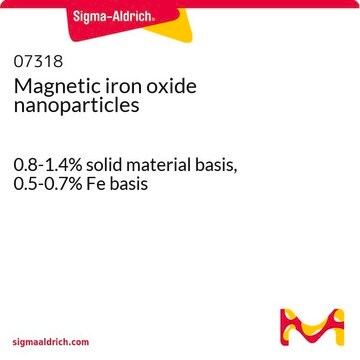700320
Iron oxide(II,III), magnetic nanoparticles solution
5 nm avg. part. size, 5 mg/mL in toluene
Sinonimo/i:
Magnetic iron oxide nanocrystals, Magnetite, Superparamagnetic iron oxide nanoparticles
About This Item
Prodotti consigliati
Forma fisica
nanoparticles
solution
Concentrazione
5 mg/mL in toluene
Magnetizzazione
≥30 emu/g (at ambient temperature under 4500 Oe)
Dimens. media delle particelle
5 nm
Dimensione particelle
5 nm±1 nm (TEM; conforms)
Densità
0.865 g/mL at 25 °C
Stringa SMILE
O=[Fe].O=[Fe]O[Fe]=O
InChI
1S/3Fe.4O
SZVJSHCCFOBDDC-UHFFFAOYSA-N
Cerchi prodotti simili? Visita Guida al confronto tra prodotti
Categorie correlate
Descrizione generale
Avvertenze
Danger
Indicazioni di pericolo
Consigli di prudenza
Classi di pericolo
Aquatic Chronic 3 - Asp. Tox. 1 - Flam. Liq. 2 - Repr. 2 - Skin Irrit. 2 - STOT RE 2 - STOT SE 3
Organi bersaglio
Central nervous system
Codice della classe di stoccaggio
3 - Flammable liquids
Classe di pericolosità dell'acqua (WGK)
WGK 3
Punto d’infiammabilità (°F)
39.9 °F
Punto d’infiammabilità (°C)
4.4 °C
Dispositivi di protezione individuale
Eyeshields, Faceshields, Gloves, type ABEK (EN14387) respirator filter
Certificati d'analisi (COA)
Cerca il Certificati d'analisi (COA) digitando il numero di lotto/batch corrispondente. I numeri di lotto o di batch sono stampati sull'etichetta dei prodotti dopo la parola ‘Lotto’ o ‘Batch’.
Possiedi già questo prodotto?
I documenti relativi ai prodotti acquistati recentemente sono disponibili nell’Archivio dei documenti.
I clienti hanno visto anche
Articoli
Graphene is a unique two-dimensional (2D) structure of monolayer carbon atoms packed into a dense honeycomb crystal that has attracted great interest due to its diverse and fascinating properties.
Professor Hui Mao explores the use of superparamagnetic iron oxide nanoparticles (INOPs) that offer an alternate contrast-enhancing mechanism.
Prof. Yadong Yin discusses various synthesis methods of magnetite nanocrystals and their applications in different fields.
Magnetic materials find diverse applications from data storage to renewable energy.
Il team dei nostri ricercatori vanta grande esperienza in tutte le aree della ricerca quali Life Science, scienza dei materiali, sintesi chimica, cromatografia, discipline analitiche, ecc..
Contatta l'Assistenza Tecnica.



